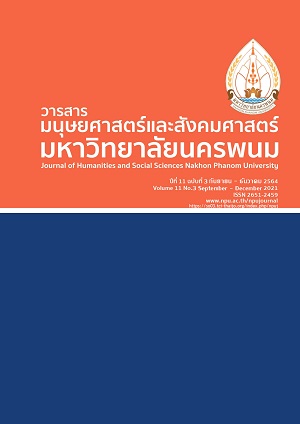Debt Analysis of Agricultural Cooperative’s Members in the Southern Thailand
Main Article Content
Abstract
The purposes of this study were to investigate: the debt of household and farmers household in Thailand in 2017, the debt and the factors that are related to the debt of agricultural cooperative’s members in the southern Thailand. Research methodology was survey research. The population and sample used in the research were 400 members of agricultural cooperatives in the southern region of 14 provinces. The instruments used was a 5-rating scale structured questionnaire which passed the quality inspection by experts with IOC value of 0.91, and the reliability test got an Alpha value of 0.914. Statistics used in data analysis were frequency, percentage, mean, standard deviation, chi–square and ordered logistic regression analysis. The findings disclosed as follows: The households in Thailand in 2017 had 50.7% of debt, the average household debt of 178,994 baht. Thai farmers households in 2017 had 67.0% of debt, the average household debt of 160,587 baht. 52.5 percent of agricultural cooperative members in the southern region have liabilities between 10,000-100,000 baht and 18.2 percent have liabilities of more than 200,000 baht. The factors that are related to the debt of agricultural cooperative’s members in the southern Thailand were: 1)the personal factors were age and education 2)the factor of values was money management and 3)the factors of consume were medical expenses and 4 basic needs (food, housing, clothing and medicine). The research contributions were 1) The members of agricultural cooperatives in the southern region can use the results of the study as a guideline for financial planning. And agricultural cooperatives in the southern region can use the results of the study to establish credit policies for members of agricultural cooperatives in the southern region.
Article Details
References
Bank of Thailand. (2019). rāingān nayōbāi kānngœ̄n 2562. [Monetary policy Report 2017]. Bangkok: Bank of Thailand. Retrieved from https://www.bot.or.th/Thai/MonetaryPolicy/MonetPolicyComittee/ MPR/BOX_MPR/1BOXMPR_TH_December2562.pdf
Bank of Thailand. (2019). khrư̄ang chī sētthakit mahaphāk khō̜ng Thai nưng. [Thailand’s Macro Economic indicators]. Retrieved from https://www.bot.or.th/App/BTWS_STAT/statistics/ReportPage.aspx? reportID=409&language=th.
Cooperative Auditing Department. (2018). rāingān phon kāndamnœ̄n ngān læ thāna kānngœ̄n sahakō̜n kān kasēt pračham pī 2560. [Performance and Finance Report of Agricultural Cooperatives 2017]. Bangkok: Cooperative Auditing Department. Retrieved from https://www.cad.go.th/ewtadmin/ ewt/statistic/download/report_info/60/kaset_2_60.pdf.
Cooperative Auditing Department. (2018). phonlakā rō̜dam nœ̄n ngān sahakō̜n pračham pī 2560. [Cooperative Performance Report 2017]. Bangkok: Cooperative Auditing Department. Retrieved from https://www.cad.go.th/ewtadmin/ewt/statistic/download/sahakorn_60/ Data60/ in60/ in_1_60.xlsx.
Jame S. Duesenberry. (1959). Income, saving, and the theory of consumer behavior (Harvard economic studies). Harvard University Press.
Keynes, J.M. (1936).The General Theory of Employment, Interest and Money, London: Macmillan;The Collected Writings of John Maynard Keynes, Vol. 6.
Mingmaneenakin W.(2008). Lak sētthasātmaha phāk. [Macroeconomics]. Bangkok: Thammasat University, Thailand.
National Statistical Office. (2017). rāidai læ kārok ra čhā yō̜ rāidai khō̜ng khrūarư̄an Phō̜.Sō̜. sō̜ngphanhārō̜ihoksip radap čhangwat. [Provincial Households Income and Income Distribution in 2017]. Bangkok: National Statistical Office. Retrieved from http://service.nso.go.th/nso/ nsopublish/pubs/e-book/Income-Households-2560/index.html#143.
Office of the National Economic and Social Development Board. (2016). sarup sāra samkhan phǣn phatthanā sētthakit læ sangkhom hǣng chāt chabap thī sip sō̜ng Phō̜.Sō̜. sō̜ngphanhārō̜ihoksip sō̜ngphanhārō̜ihoksipsī. [Summary of Twelfth National Economic and Social Development Plan 2017 – 2021]. Retrieved from https://www.nesdb.go.th/download/plan12.pdf.
Phocaphanit S. and Kenaphoom S. (2017). kānsưksā khwāmkhithen kīeokap patčhai thī song phon tō̜ phāra nīsin khō̜ng kasēttrakō̜n ʻamphœ̄ thā bō̜ čhangwat nō̜ngkhāi. [Factors Affecting Debt Burden of Farmers ThaBo District NongKhai]. Journal of MCU Peace Studies Special Issue, 192-201. Maha Sarakham: Maha Sarakham Rajabhat University, Thailand.
Tairuakum S. (2009). rabīap withī wičhai samrap manutsayasāt læ sangkhommasāt. [Research methodology for social sciences and humanities]. 3rd. edition. Maha Sarakham: Maha Sarakham University, Thailand.


